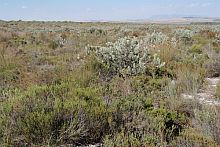German student visits Fynbos Node: A collaborative project for long-term monitoring
|
German Diploma student, Kim Knauer, from the University of Würzburg is visiting the Fynbos Node to work on a project aimed at developing a long-term remote sensing monitoring tool to assess Fynbos vegetation condition.
While in South Africa, Kim will be ground truthing MODIS (Moderate Resolution Imaging Spectroradiometer) data which he has already processed for his thesis. The study is a collaborative project between Dr Doris Klein of the German Aerospace Institute, DLR, and the SAEON Fynbos Node. Dr Klein is supervising Kim’s Diploma thesis. The Diploma course is equivalent to achieving a Master’s degree in South Africa.
We decided to focus on lowland Sand Fynbos as one of the most critically endangered vegetation types in the Fynbos Biome to develop this monitoring tool. Sand Fynbos is one of the priority vegetation types for conservation identified by the Biodiversity Management Group of the City of Cape Town. Its original extent has been seriously reduced by expanding urbanisation, agriculture and invasive alien plants.
MODIS Enhanced Vegetation Index (EVI) data are selected because, with data produced every sixteen days for a given pixel, these can indicate when vegetation is photosynthetically active. Ground truthing will involve the determination of current cover of invasive and indigenous vegetation as well as different plant functional groups.
The MODIS data will be analysed using rainfall extrapolated from South African Weather Services records for nineteen stations to see how peaks in EVI for different vegetation cover types correlate with rainfall across a rainfall gradient. If this analysis proves fruitful we will use differences in vegetation cover type responses to season and rainfall to develop the monitoring tool.
 |
|
Graph: Rainfall and EVI (enhanced vegetation index) derived from MODIS spectral bands for a Sand Fynbos site over a nine year period. Vegetative production, as shown by EVI, tracks rainfall.
|





